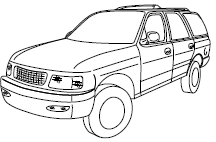Notice to utility vehicle and truck owners
Utility vehicles and trucks handle differently than passenger cars in the various driving conditions that are encountered on streets, highways and off-road. Utility vehicles and trucks are not designed for cornering at speeds as high as passenger cars any more than low-slung sports cars are designed to perform satisfactorily under off-road conditions.

![]() WARNING:
Utility vehicles have a significantly higher rollover rate than other types of vehicles.
To reduce the risk of serious injury or death from a rollover or other crash you
must:
WARNING:
Utility vehicles have a significantly higher rollover rate than other types of vehicles.
To reduce the risk of serious injury or death from a rollover or other crash you
must:
• Avoid sharp turns and abrupt maneuvers;
• Drive at safe speeds for the conditions;
• Keep tires properly inflated;
• Never overload or improperly load your vehicle; and
• Make sure every passenger is properly restrained.
![]() WARNING:
In a rollover crash, an unbelted person is significantly more likely to die than
a person wearing a seat belt.
WARNING:
In a rollover crash, an unbelted person is significantly more likely to die than
a person wearing a seat belt.
All occupants must wear seat belts and children/infants must use appropriate restraints to minimize the risk of injury or ejection.
Study your owner’s guide and any supplements for specific information about equipment features, instructions for safe driving and additional precautions to reduce the risk of an accident or serious injury.
See also:
Rear window defroster
HEATED WINDOWS AND MIRRORS (IF EQUIPPED)
Heated Rear Window
Note: The vehicle must be running to use this feature.
Press the control to clear the rear window of thin ice and fog. Press the control ...
Vehicle identification number
The vehicle identification number is located on the driver side instrument panel.
Please note that in the graphic, XXXX is representative of your vehicle identification
number.
The Vehicle Ident ...
Cleaning the instrument panel and instrument cluster lens
WARNING: Do not use chemical solvents or strong detergents when cleaning
the steering wheel or instrument panel to avoid contamination of the airbag system.
Clean the instrument panel and cluster l ...
